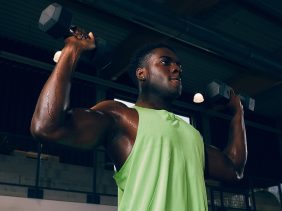How to Reach Your Healthy Body Goals — All At Once
 ©PeopleImages
©PeopleImages
For decades, we were inundated with messages that said you had to pick your body goal and never deviate. And that usually fell into one of two categories: lose weight, or gain muscle. The weight loss people were shuttled to the cardio area of a gym and told to glue themselves to the machine for hours, and to feast on a salad afterward. Dressing on the side, please.
Meanwhile, the muscle builders were eating or drinking their nutrition before, during, and after pumping iron. If you can lift heavier, you should lift heavier. Counting your macros is preferred. And don’t really worry too much about cardio, cross-training, or mobility. If you can pick up the barbell and put it back down, you’re good to go.
Related: What’s more effective for weight loss: Cardio or strength training?
These days, the conversations are changing. Rather than weight loss for the sake of losing weight, it’s about people finding the body size that makes them feel good, and using movement to help the function of the entire body — not simply your waist size. Muscle builders are getting that message, too. Cross-training and doing other activities as recovery can help your heart, improve your mobility, and make you more injury-resistant.
So if you’ve only been focusing on one goal, it might be time for a rethink. And it might even require changing the question you ask yourself. Rather than what do you want to look like, what do you want to feel like?
How things go depends on where you’re starting from.
If you’re new to exercising, or haven’t done it consistently in a while due to something like an injury or a big life change, you’ve actually unlocked a pretty cool thing: starting and sticking to a new workout program can have pretty fast results. That’s because the training is new to your muscles, which will react to this unfamiliar strain by growing — even if you don’t eat any more than you were before. The key is to dial things up slowly. Depending on things like your current fitness level, age, experience with exercising, and genetic makeup, it could take longer for you to witness the changes that you’re hoping for. Be patient. The name of the game is consistency. The results that happen after two weeks are not as important as the ones that can happen after two months, or two years even.
Strength training is always a good investment in your health, whether you are a beginner or an advanced athlete. Muscle is unique in that it metabolises more calories at rest than fat does. The more muscle mass you have, the more energy you use even at rest.
To get to know your body better, see our Body Check.
One thing to keep in mind is that weighing yourself isn’t going to give you a particularly accurate picture of what’s going on with your body. You could be making “gains” on a cellular level, and your body composition could be changing, even if the scale isn’t telling that story. Ask yourself, are you sleeping better? Do you feel stronger? Can you last longer in your cardio sessions, add another round to a HIIT workout, or throw a few more plates on your deadlift now compared with a few weeks ago? If you’d been feeling things like joint pain, lethargy, or foggy headedness, are those starting to resolve? How’s your digestion? And what’s your mood been like lately? If you can say that you’ve experienced improvements in some of these ways, to hell with what the scale says.
Related: 5 diet mistakes you need to stop making
For advanced athletes who already have their fitness and eating programs dialed in, it’s a bit of a different story. If you are trying to change your body composition for something like the start of a new track season, or looking forward to a wrestling competition in which you’re trying to get into a certain weight class, it is not possible to lose fat and build muscle mass at the same time. The reason: Your muscles are now growing much more slowly than at the beginning. You also do not have enough energy reserves in the form of fat to continue to build muscle in the deficit. So decide on one thing. If you want to build more muscle, you need a calorie surplus. If fat reduction is your top priority, a calorie deficit is the solution. A new training plan can also help you build muscle mass. Because your body has to adapt to the new load.
The best solution: eat in ways that fuel your movement — and your life
Competitive athletes will be best served by hooking up with a sports dietitian and a trainer who can help you find the right formula that’ll keep you in tip top shape. The rest of us don’t need to be so rigid. Eating balanced meals with whole foods and lots of produce help our bodies function—and not just in the gym, but throughout the whole of the day.
If you are looking for a little more structure, consider what you need:
- The right diet. It provides you with new energy and proteins.
- The recovery period between your training sessions. Your body needs this to build up and recover.
- The right workout. This ensures that your muscles get a growth stimulus. In combination with proper nutrition and recovery periods, you build muscle mass.
Try our whey protein either before or after exercising.
What’s the best workout for you to change your overall body composition?
Strength endurance training—in the form of high-intensity interval training, or HIIT—is well suited to the goal of losing fat and building muscle. In addition to HIIT, there’s also Tabata or circuit training, all of which stimulate your muscles and require energy expenditure.
Classic strength training can also help you to achieve your goal. Make sure that you regularly increase your training or set new stimuli.
And it’s not just about what happens in the gym. Taking a walk with a friend, biking to the grocery store or pharmacy instead of taking the car, jogging to pick up take-away food instead of having it delivered — all the little things add up!
What’s for dinner? And breakfast and lunch, too?
Balanced meals are going to help you feel satisfied and energized. That means getting a little bit of nutrition from all of the food groups:
- Proteins from e.g. poultry, low-fat yogurt, legumes or tofu.
- Carbohydrates from rice, potatoes, whole grains or oatmeal
- Healthy fats from plants such as olives, nuts or avocados and animal fat from fish
- a portion of vegetables for important vitamins
More healthy eating tips from foodspring:
- Summer Meal Ideas to Stay Cool
- 14 Easy High-Protein Breakfast Ideas
- 12 foods for muscle building that you should always keep in your pantry
Sources for this article
We at foodspring use only high-quality sources, including peer-reviewed studies, to support the facts within our articles. Read our editorial policy to learn more about how we fact-check and keep our content accurate, reliable, and trustworthy.
- Gary John Slater, Brad P. Dieter: Is an Energy Surplus Required to Maximize Skeletal Muscle Hypertrophy Associated With Resistance Training. In: Front. Nutr., 20 August 2019. https://www.frontiersin.org/articles/10.3389/fnut.2019.00131/full?fbclid=IwAR1CTkF9a5fH8JqW6hnpipjtBuN_Cykk6kWHP3Z9e4Mvido-LoxeDd4Umq8
































